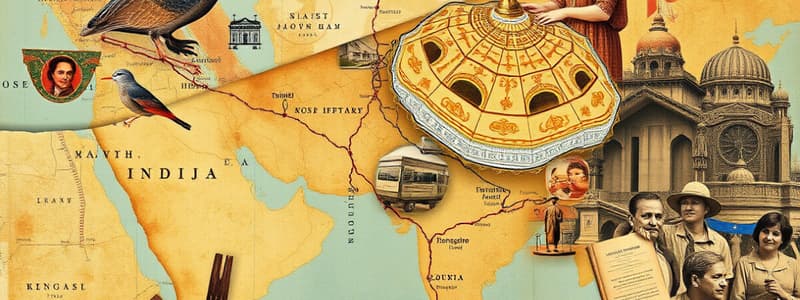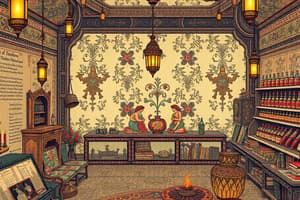Podcast
Questions and Answers
The rise of the Turks in West Asia in 1453 had no impact on trade routes to Europe.
The rise of the Turks in West Asia in 1453 had no impact on trade routes to Europe.
False (B)
Vasco da Gama was the first European to reach India by land.
Vasco da Gama was the first European to reach India by land.
False (B)
The Mughal emperors recognized the Europeans as a significant threat and focused on strengthening their navy.
The Mughal emperors recognized the Europeans as a significant threat and focused on strengthening their navy.
False (B)
The Portuguese established a trading company in India in the 16th century.
The Portuguese established a trading company in India in the 16th century.
Bartolomeo Dais was an explorer who helped discover a direct sea-route to India.
Bartolomeo Dais was an explorer who helped discover a direct sea-route to India.
The Europeans acquired trading privileges from the Mughal emperors to establish small trading settlements in India.
The Europeans acquired trading privileges from the Mughal emperors to establish small trading settlements in India.
By the 18th century, regional powers in India began to lose their independence.
By the 18th century, regional powers in India began to lose their independence.
The Portuguese maintained a monopoly over Indian trade with Europe throughout the 18th century.
The Portuguese maintained a monopoly over Indian trade with Europe throughout the 18th century.
Vasco da Gama captured Goa in 1510 from the Sultan of Bijapur.
Vasco da Gama captured Goa in 1510 from the Sultan of Bijapur.
The Dutch East India Company was founded in 1602.
The Dutch East India Company was founded in 1602.
The Portuguese maintained a strong hold on their inland territories throughout their reign in India.
The Portuguese maintained a strong hold on their inland territories throughout their reign in India.
Queen Elizabeth I allowed the English East India Company to trade with India for no cost.
Queen Elizabeth I allowed the English East India Company to trade with India for no cost.
The British built Fort St. George after leasing Madras from Nayak Damarla Venkatappa.
The British built Fort St. George after leasing Madras from Nayak Damarla Venkatappa.
The French East India Company was privately owned by merchants.
The French East India Company was privately owned by merchants.
The English East India Company was granted the right to trade in Bengal with no duties by Aurangzeb.
The English East India Company was granted the right to trade in Bengal with no duties by Aurangzeb.
Bombay was transferred to the English East India Company as part of the Treaty of Bassein.
Bombay was transferred to the English East India Company as part of the Treaty of Bassein.
Chandernagore was a fortified trading center established by the English East India Company.
Chandernagore was a fortified trading center established by the English East India Company.
The success of the Dutch trading power posed a significant threat to the British ambitions in India.
The success of the Dutch trading power posed a significant threat to the British ambitions in India.
Flashcards are hidden until you start studying
Study Notes
Indian Trade with the West
- Centuries-old trade between India and the West primarily involved spices, textiles, sugar, indigo, and saltpetre.
- The Arab traders controlled the trade routes, transporting goods from Indian ports to the Persian Gulf and Red Sea before overland delivery to Europe.
- The rise of the Turks in West Asia in 1453 disrupted established trade routes, prompting European nations to seek sea routes to India.
European Exploration and Arrival
- Vasco da Gama, in 1498, became the first European explorer to reach India, landing in Calicut after sailing around the Cape of Good Hope.
- His discovery established a direct sea route to India, attracting other European powers like the Dutch, British, and French for trade.
- Mughal emperors did not initially view Europeans as threats, allowing them to establish small trading settlements.
Decline of Mughal Power
- By the 18th century, regional powers in India began asserting independence, leading to changing dynamics in trade and power.
- European trading companies started to ally with local rulers, increasing their own power at the cost of the Mughal Empire.
The Portuguese in India
- The Portuguese were the first Europeans to set up a trading company in India, dominating trade in the 16th century due to their strong navy.
- Vasco da Gama established friendly relations with local rulers, and Albuquerque captured Goa in 1510, using it as headquarters.
- By the late 16th century, Portuguese power declined due to weak leadership and competition from Dutch and British companies.
The Dutch East India Company
- Founded in 1602, the Dutch East India Company emerged as a strong trading power in the 17th century.
- The Dutch broke the Portuguese monopoly in the Indian Ocean and established key trading centres but later focused on settlements in Southeast Asia.
- The British capitalized on the Dutch's weakened position, gradually diminishing their influence in India.
The British East India Company
- Founded in 1600, the English East India Company received a royal charter from Queen Elizabeth I to trade with India.
- In 1615, the British secured permission from Mughal Emperor Jahangir to establish a factory in Surat.
- Gradually expanded, the British created fortified factories, notably building Fort St. George in Madras and expanding into Bengal and Bombay.
Transformation from Traders to Rulers
- British officials initially focused on trade but shifted towards political control under Chairman Sir Josiah Child, who aimed to establish an empire in India.
- After a failed attempt to capture Chittagong, the Company faced setbacks but gained significant rights to trade and collect taxes from Mughal authorities.
- The growth of cities like Calcutta, Madras, and Bombay attracted Indian merchants, leading to British dominance in India.
French Presence in India
- The French East India Company, established in 1664, differed from the English version as it was state-controlled rather than privately owned.
- The French established fortified trading posts in Pondicherry and later expanded to Chandernagore and Mahe.
Acquisition of Bombay
- Bombay, originally consisting of seven islands, was acquired by the Portuguese through the Treaty of Bassein.
- The British received Bombay as a dowry when Catherine of Braganza married King Charles II, who transferred it to the English East India Company in 1668.
Studying That Suits You
Use AI to generate personalized quizzes and flashcards to suit your learning preferences.




